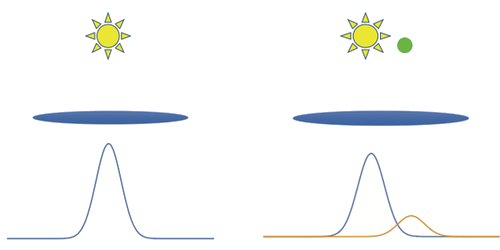Finding Exoplanets with Quantum Imaging
Of the approximately 4500 known extrasolar planets, only about 1% were found by imaging the planets directly. The reason for the low direct-detection rate is that the dim light scattered from an exoplanet is hard to recognize amid the glare of the planet’s parent star. Now, Zixin Huang at Macquarie University, Australia, and Cosmo Lupo at the University of Sheffield, UK, predict that quantum imaging could significantly improve the probability of directly detecting an exoplanet [1]. They also show that the ultimate sensitivity limit for this task is already reachable for two currently available techniques—one based on interferometry, the other on the decomposition of light from the image from a star into different spatial modes (see Viewpoint: Unlocking the Hidden Information in Starlight).
Huang and Lupo approach the task of finding planets by treating the problem as one of quantum state discrimination, where the two quantum states—“star plus planet” and “star only”—are linked to the spatial distribution of the detected photons. They find that the probability of correctly discriminating between these states depends on the angular separation between the star and the planet, the brightness ratio of the two objects, and the number of photons collected by the telescope.
The researchers predict that, as these variables change, the “discrimination-error” probability of their quantum approach scales differently from the classical approach. They find that only quantum-imaging techniques reach the fundamental error-probability limit. Thus, compared to current methods, quantum techniques should be able to detect exoplanets that are dimmer, closer to their stars, or both.
–Marric Stephens
Marric Stephens is a Corresponding Editor for Physics Magazine based in Bristol, UK.
References
- Z. Huang and C. Lupo, “Quantum hypothesis testing for exoplanet detection,” Phys. Rev. Lett. 127, 130502 (2021).




